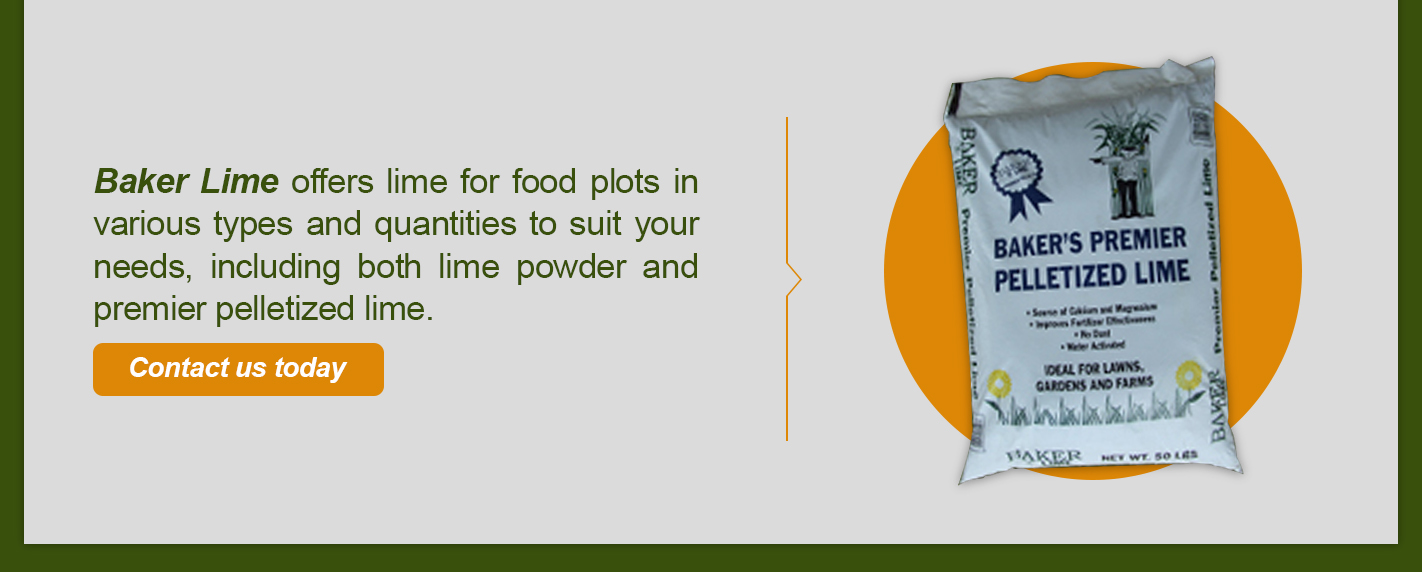Using Lime for Food Plots
Table of Contents
View Our Pelletized Lime Find Your Local Distributor
Author/Reviewed By: Josh Miller, Sales Manager: Baker Lime & North America Minerals
Published: 6/8/2018 – Updated: 4/7/2020
Limestone helps farmers improve the quality of their crops and private homeowners maintain beautiful lawns and gardens, but limestone treatments can also be used to improve your wildlife food plot. Whether you’re thinking about creating a food plot or you’re dissatisfied with your current plot, lime can help you grow better crops to attract more deer & wildlife to your food plot.
In this piece, we will walk you through the steps of how to start a food plot from scratch and also provide food plot tips for hunting success this season.
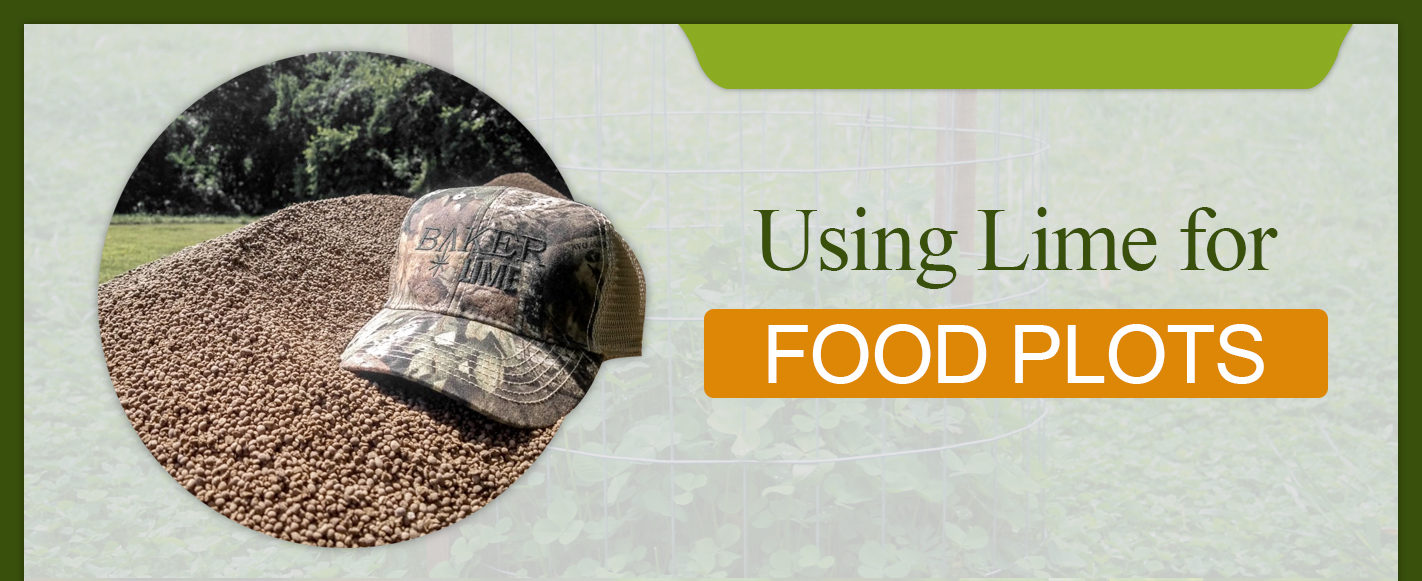
How to Start a Food Plot
With all the talk about pH balance, soil nutrients and crop selection, starting a food plot may sound complicated if you’ve never done it before. However, starting a food plot can actually be fairly simple when you follow these 10 basic steps.
1. Determine the Goals of Your Food Plot
The purpose of your food plot will determine the location of your food plot, how you prepare your plot, what you plant and when you plant it. Food plots for deer generally have two primary goals:
- Animal nutrition: Food plots can provide food for deer throughout the year to help fawns develop faster and promote body and antler growth in mature deer. Food plots for animal growth should be designed to make deer feel safe while they are feeding and should be hunted very sparingly, if at all. These food plots can be planted with warm-season forage for deer to feed on during the spring and summer.
- Hunting: Food plots can also be used to draw deer or other game to your property for hunting. Food plots for hunting are planted with cool-season forage to attract deer in the fall and winter during hunting season. Food plots placed strategically along deer trails can be the perfect spot to bag a big buck.
If your property is large enough to plant several plots, the best strategy is often to have both food plots for nutrition and hunting plots. This will draw deer to your property all year long, while also helping them grow bigger for an even better hunting season next year.
Food plots for animal nutrition can also be used for wildlife conservation. Food plots for conservation provide an additional energy source to help wildlife populations within an ecosystem grow. These plots can target a variety of species — such as songbirds, wild turkey, bear, and rabbits. While this article will focus on starting a food plot for deer nutrition and hunting, you can follow similar steps to plant a wildlife food plot for conservation or a hunting plot for other types of game.
2. How to Find the Right Location for your Food Plot
Now that you have a goal in mind, you can begin searching for the perfect location for your food plot. Food plots for deer growth can be placed in more open areas — such as at the edge of your yard, along deer trails or in fields. Hunting food plots should be placed in more wooded areas where deer can easily find shelter and where hunting is permitted. Here are a few things to look for when choosing the best spot for your food plot:
-
- Near cover: Deer feel most comfortable grazing when they are near coverage, such as bushes, trees, rock piles or tall grasses.
- Away from roads: Older deer will avoid food plots where they can see or hear vehicles. If you must place a food plot near a road, plant evergreens or other thick vegetation to block roadway sounds and visibility.
- Close to a water source: Deer will often travel near sources of fresh water, such as streams, creeks, rivers and ponds.
- Along deer trails: Deer typically follow travel corridors from their bedding areas to larger feeding spots like fields. Placing small food plots along these trails can catch deer as they roam.
- Upwind from hunting stands: Consider the prevailing winds in the area and plant your food plot upwind from your hunting stand. This allows you to access your stand without grazing deer catching your scent.
- Even and clear ground: Areas with flat ground that are free of rocks, tree stumps and shrubs will be best for growing crops for your food plot.
- Not too shaded: While some plants can grow in shaded areas, most plants grow best when they receive at least six hours of sunlight each day. If you can find a clearing that gets eight to 10 hours of sunlight, that’s even better.
A few great locations for food plots are clearings in wooded areas, overgrown fields in forests and corners of farmland that are not being used. Food plots can be planted in irregular shapes, so do not worry about trying to find a perfect rectangular plot. Food plots can also range in size from just a fraction of an acre to two or three acres, depending on how much property you own and the purpose of the plot. Nutrition plots are generally larger while hunting plots can be as small as a tenth of an acre.
3. Clear Your Plot
Once you have chosen your spot, clear out any vegetation, trees, logs, stumps, grasses and weeds by using a tractor, tiller or shovel. You can also apply a broad-spectrum herbicide to kill any remaining weeds or grasses. If using a herbicide, be sure to wait at least a week after spraying to do anything else to the soil, including applying fertilizer and lime.
4. Decide What You Want to Plant
The best plants for your food plot will depend on the type of game you want to attract, when you want to plant, the climate where you live and the location of your food plot. Different crops grow best in different temperatures and with different amounts of sunlight and precipitation.
Look for crops that are not already abundant in your area. If you live in a region with a lot of corn fields, planting another small plot of corn is not likely to attract a lot of deer, while a plot of clover may be more effective.
The size of your plot also impacts which plants will bring the most hunting success. Some crops — such as corn or soybeans — can be overbrowsed by deer very quickly, while other crops — like clovers and brassicas — can withstand more browsing pressure. When planting a small food plot, choose crops that can withstand heavy browsing to keep deer coming to your plot all season.
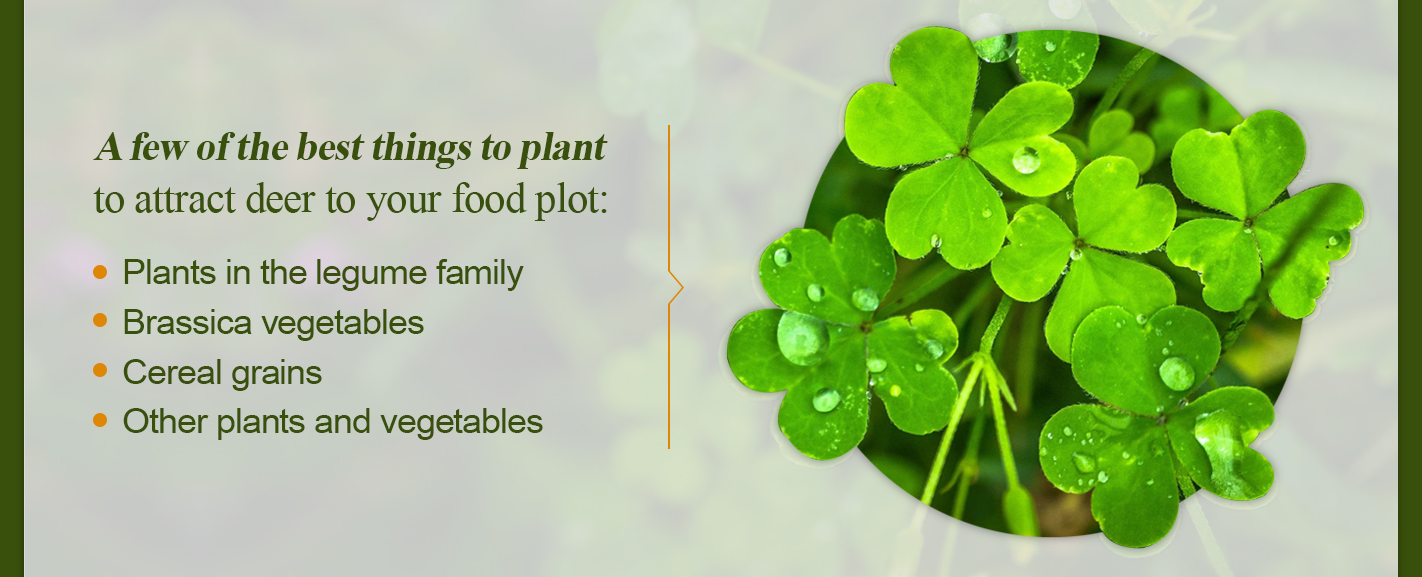
Here are a few of the best things to plant to attract deer to your food plot:
- Plants in the legume family: Such as clover, alfalfa, soybeans and cowpeas
- Brassica vegetables: Such as turnips, radishes, kale, cabbage and rapeseed
- Cereal grains: Such as oats, wheat, rye, sorghum and corn
- Other plants and vegetables: Such as chicory, beets and lablab
You can also create a blend of seeds or purchase a seed blend that combines some of these popular food plot crops. If you are creating your own blend of crops, choose crops with a similar growing season and requirements for light, precipitation and soil nutrients.
5. Test The Soil on Your Food Plot
While it may be tempting to skip this step to cut costs, testing your soil and applying the right fertilizer is essential for growing healthy plants to attract big bucks. Even if you find the perfect location and growing conditions, poor soil quality can quickly ruin a crop.
A soil test uses soil samples to measure the amount of available nutrients in the soil — including primary nutrients like phosphorous, potassium and nitrogen, and micronutrients like calcium, magnesium, sodium, sulfur, manganese, copper and zinc. The amount of available nutrients determines what kind of fertilizer is best for your food plot and how much fertilizer you should apply to grow healthy plants.
Soil tests also measure the pH level of the soil, which determines how much lime you should apply to your food plot to bring it up to the correct pH level. In general, a pH level between 6.0 and 7.0 is the ideal range for deer food plots. If your soil is too acidic, your plants will not be able to get nutrients from the soil and will grow sparsely or not at all. If your crop is lower quality, your food plot will attract fewer deer, and deer who feed from it will not receive as many nutrients to help them grow.
To test your soil, you can purchase a soil test kit from a garden supply or home improvement store or send soil samples into a lab for testing. Many local universities offer soil testing at an affordable price. When you send your soil sample in for analysis, you will get a full report with recommendations for liming and the best fertilizer mix for your specific crop and soil.
6. Apply Lime to Your Food Plot
After receiving your soil analysis, apply the recommended amount of lime to your plot about four months before you plant your seeds. Most areas will require about one to three tons of lime per acre, but this will vary based on your soil test results. Liming your food plot balances your soil pH level, which improves plant yield, increases plant growth and makes fertilizer more efficient.
Lime is available in powder or pellet form and can be purchased in bulk to reduce costs. To apply lime powder to your food plot, spread the lime over the surface of the food plot using a drop spreader. Lime powder is finely ground, making it easy to apply evenly and cover more surface area. When applying lime powder, wear a face mask to avoid breathing it in and avoid liming on a windy day.
To apply lime pellets, spread them over your food plot using a basic broadcast spreader or tractor spreader for larger plots. For small food plots, you can spread your lime pellets by hand. Lime pellets for food plots offer several benefits over traditional agricultural lime — they are designed to break down easily to release lime quickly and can be applied without the use of specialized equipment.
After applying lime, integrate it into the soil for faster results. Using a plow, disk or tiller, work the soil to mix the lime at least six inches deep. Lime takes time to activate and fully work. You don’t just apply it to the soil and then it’s fixed overnight. When applied effectively, lime can begin working in a couple weeks but can take around four months to balance the pH level in your soil. Apply the lime at least four months before planting a new crop for best results.
7. Fertilize Your Food Plot
If the pH level of your food plot is too low, it is essential to apply lime first, before adding fertilizer. Even the best fertilizer for food plots cannot work effectively unless the soil is already at the right pH balance. By neutralizing your soil pH first, you maximize the benefits of fertilizing.
What fertilizer to use for deer food plots depends on your soil. To select the best fertilizer for food plots, follow the recommendations of your soil test. Fertilizer bags have three numbers on them that represent the amount of nitrogen, phosphorus and potassium, respectively. You can select a fertilizer mix that best matches the nutrient needs of your soil, or you can request a custom mix from a fertilizer company. When applying fertilizer to your food plot, use the amount recommended in your soil analysis.
8. Plant Your Seeds
Now that your food plot is prepared, it’s time to put your green thumb to the test. Plan ahead to determine the right time to plant your crops based on their growing season and how long the plant needs to reach maturity. If seeds are planted too early, they can die from a frost. If seeds are planted too late, you may miss the ideal temperature and precipitation window for seed germination, resulting in lower yield and lower quality crops.
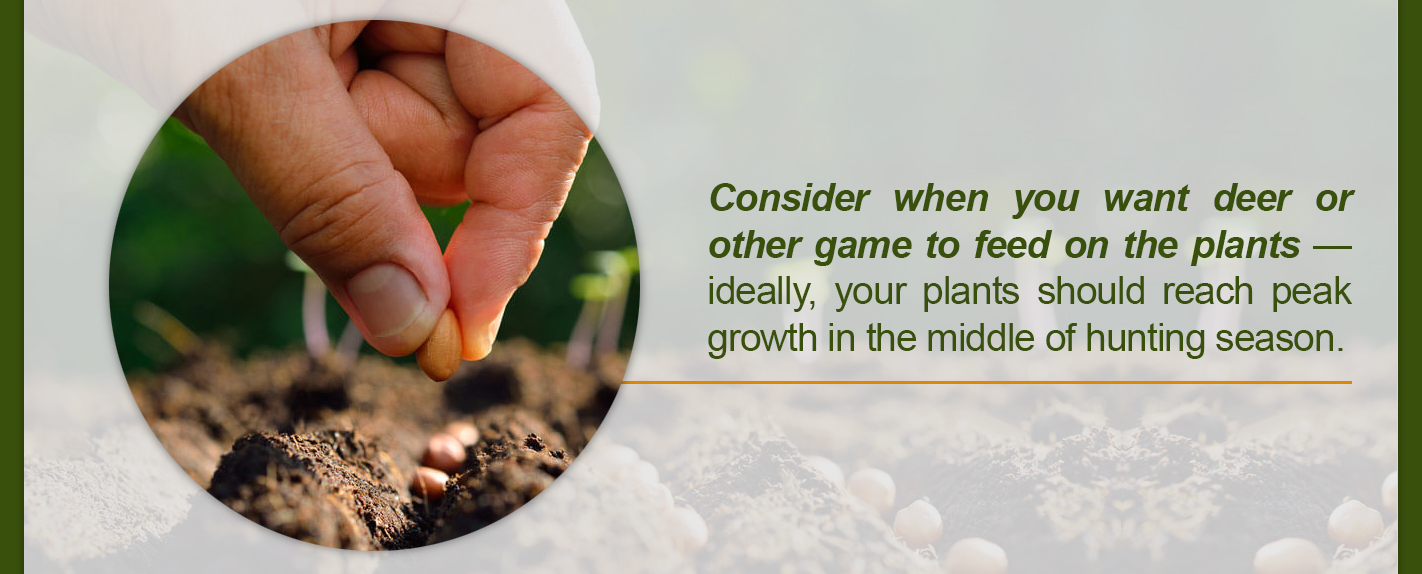
Consider when you want deer or other game to feed on the plants — ideally, your plants should reach peak growth in the middle of hunting season if in a “hunting plot”.
Here are a few general guidelines for when to plant food plots in Pennsylvania:
- Early spring: Plant warm-season forages such as corn, soybeans, cowpeas, grain sorghum and lablab in the spring. These plants require a full growing season to reach maturity but will stay green all summer and into the fall. Early spring plantings are best for deer food plots for animal nutrition.
- Late summer or early fall: Cereal grains and vegetables in the brassica family can be planted in late summer to reach maturity in just a few months. Clovers can also be planted in late summer under the shade of brassicas or grains. These plants are often a favorite for hunting plots as they will stay green throughout the fall hunting season.
- Spring or fall: Cool-season perennial forages — including some grains, brassicas, clovers, alfalfa and chicory — can be planted in the spring or fall, depending on the goals of your food plot. If planted in the fall, these crops will start to establish a root system the first year and will grow in full the following year. Planting perennials is a great way to establish a deer food plot that will be successful for many years to come.
When planting seeds, first till the soil to loosen the earth and then use the correct planting technique for your specific crop. Some seeds can be spread on the surface of the soil, while others need to be planted slightly below the surface. The size of seed generally dictates how deep it should be planted — sprinkle small seeds on the surface and let the rain cover them, but push larger seeds into the soil. Follow the instructions on each seed packet to plant the right amount of seeds for the size of your food plot.
9. Bag a Big Buck
Once you have followed these steps for how to start a food plot, it’s time to start hunting. Deer food plots in wooded areas can be extremely effective at drawing bucks and can provide the perfect hunting spot. A successful food plot can draw so many deer that you will want to hunt there every day — however, be careful not to over-hunt your deer food plot. After you hit a buck near your food plot, deer may be scared away or will learn to browse your plot only at night. To make the most of your food plot, hunt along deer trails leading to your plot and in surrounding areas, as well.
10. Maintain Your Food Plot for Future Success
During the growing season, maintain your food plots by weeding them or spraying them with herbicides periodically to remove aggressive weeds. Clover plots can also be mowed to remove weeds and rejuvenate the plants.
Food plots also require yearly maintenance and upkeep if you want to enjoy another successful hunting season next year. Annual crops need to be planted each year, and, although perennials will come up every year, they still require weeding and fertilizing to produce a good yield.
Liming also isn’t a one-and-done thing. You should regularly monitor the pH level of your soil and reapply lime when it becomes too acidic. Applications can be done every couple years or annually depending on your soil’s composition, and this is why regular monitoring of the soil’s health is important for a healthy plot. If you experience problems during a growing season, that is also a great time to test your soil and treat it with lime as necessary.
When to Start a Food Plot
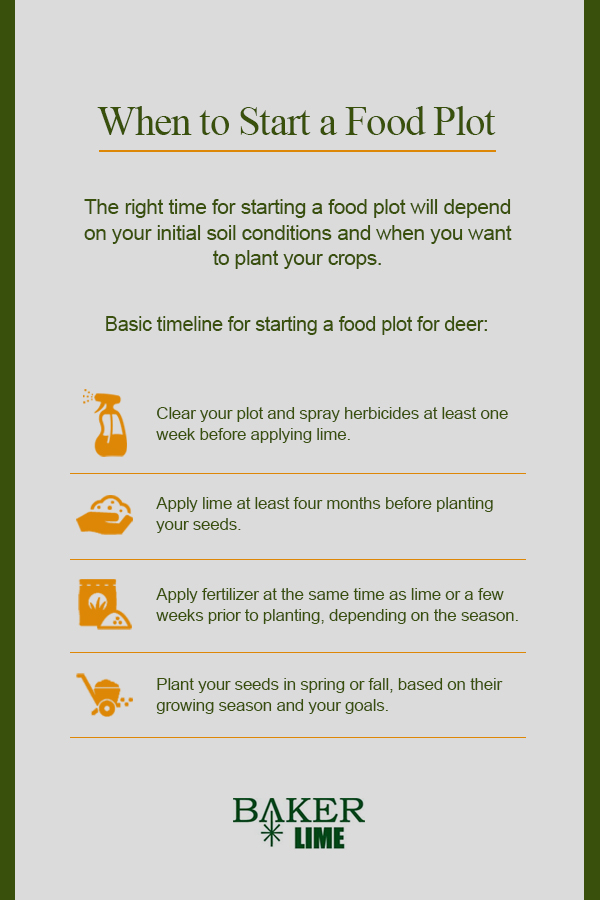
The right time for starting a food plot will depend on your initial soil conditions and when you want to plant your crops. However, because lime can take several months to be fully effective, it is essential to plan ahead for the most food plot success. Here is a basic timeline for starting a food plot for deer:
- Clear your plot and spray herbicides at least one week before applying lime
- Apply lime at least four months before planting your seeds for best results
- Apply fertilizer at the same time as lime or a few weeks prior to planting, depending on the season
- Plant your seeds in spring or fall, based on their growing season and your goals
The best time to start food plot preparation is often the fall prior to when you want to plant. Clearing your plot and applying lime before the first fall frost allows plenty of time for the lime to react with the soil. When spring rolls around, your soil will be ready for fertilizing and planting.
Benefits of Using Lime on Food Plots
Liming your food plots is an essential part of deer food plot success. As you grow plants in your soil, the acidity steadily rises. Higher acidity in the soil creates negative effects on your plants. By treating your soil with lime, you help balance the pH levels and are able to grow higher-quality plants. Liming your plots will help your crops better absorb the necessary minerals, like calcium and magnesium. It can also remove some harmful toxins from the soil.
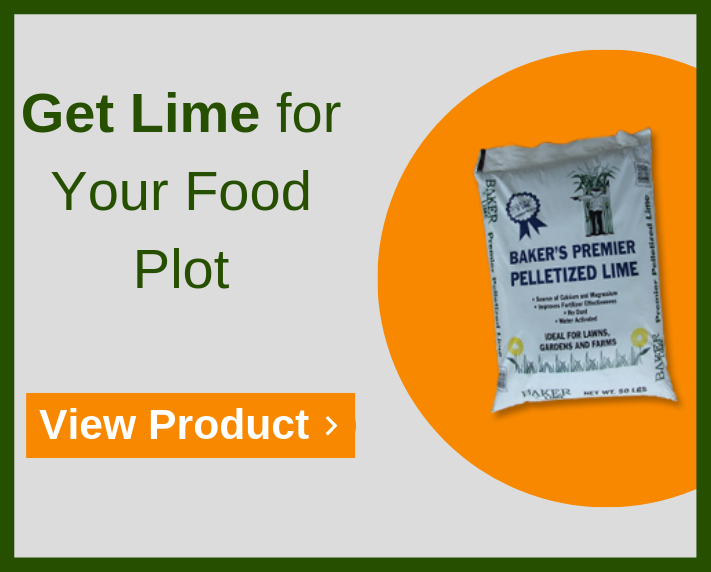
Your soil’s composition depends on your geographic location. You may live in an area where the foods that deer love grow more naturally. If you don’t, you may have had to pick crops that deer like, but don’t love. Using limestone in your food plots can help you grow the foods that deer love, like alfalfa, ladino clover and oats. With a reliable source of food they love, deer are sure to begin routinely coming to your plot to feed.
With healthier soil, you will have better crops. Using limestone on your food plots will let you grow larger and more robust plants. Correct soil pH also makes herbicides and fertilizer more effective, which improves plant quality even more. The deer can probably tell a difference. If they’re getting a tastier meal at your plot than at other spots, they’ll keep coming back. Greater crop yield also means your food plot can withstand more browsing to attract more deer. When your food plot is consistently full of hungry deer, you have a better chance of bagging the best buck.
When the deer start eating better, they will become healthier animals, too. This will help the deer to grow healthier, bucks to grow larger antlers, and general increased health of the deer population in the area. If you want to enjoy a bountiful hunting season or help grow larger and healthier bucks on your property, liming your food plots is well worth the investment.
Buying Bulk Lime for Food Plots
Whether you are preparing one food plot or many, buying lime in bulk can save a lot of money and streamline your food plot planting process. Baker Lime’s high-quality lime products are perfect for planting a better deer food plot or any other jobs you have in mind. Baker Lime offers lime for food plots in various types and quantities to suit your needs, including both lime powder and premier pelletized lime. Our high-quality lime is also affordably priced, making it even easier to start a successful deer food plot this season.
Find and contact your local Baker Lime dealer today for more information or to request a quote on our food plot lime for sale.
Don’t Just Take Our Word for It – Read More on Wide Open Spaces
Dustin Prievo with Top Pin Outdoors recently published articles on Wide Open Spaces about the cost of and tips on creating a food plot. For his food plot, he knew that he would need pelletized lime to neutralize the pH of the soil and ensure the plants were getting enough nutrients. Pulverized lime requires the correct spreading equipment to effectively spread it which makes pelletized lime a great choice for hunters. Our Premier Pelletized lime works great with your typical broadcast spreader you may use in your yard, as well as other spreader types that may be better suited for smaller equipment for easier access to food plots in smaller or wooded areas!
Not only is our pelletized lime high-quality and perfect for food plots, but it’s also very affordable compared to other options. As Dustin researched, with our lime, the savings per ton are $220 on average.
By working with us, Dustin saved hundreds of dollars on lime for his food plots. Read more about how we helped create another successful food plot on Wide Open Spaces – Secrets to Saving Money on Lime for Flood Plots and Does the Groundhog MAX ATV/UTV Disc Plow Really Work?





